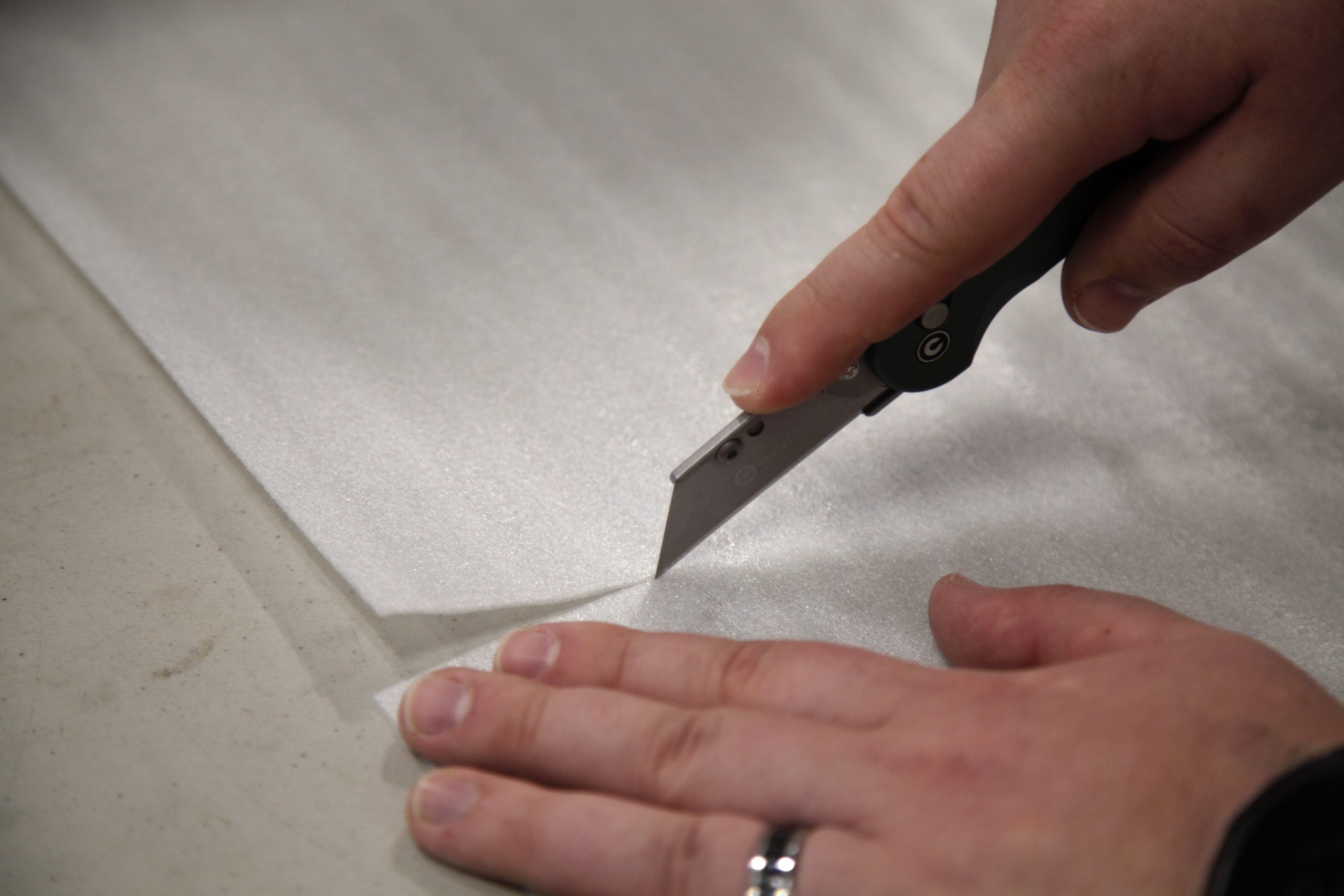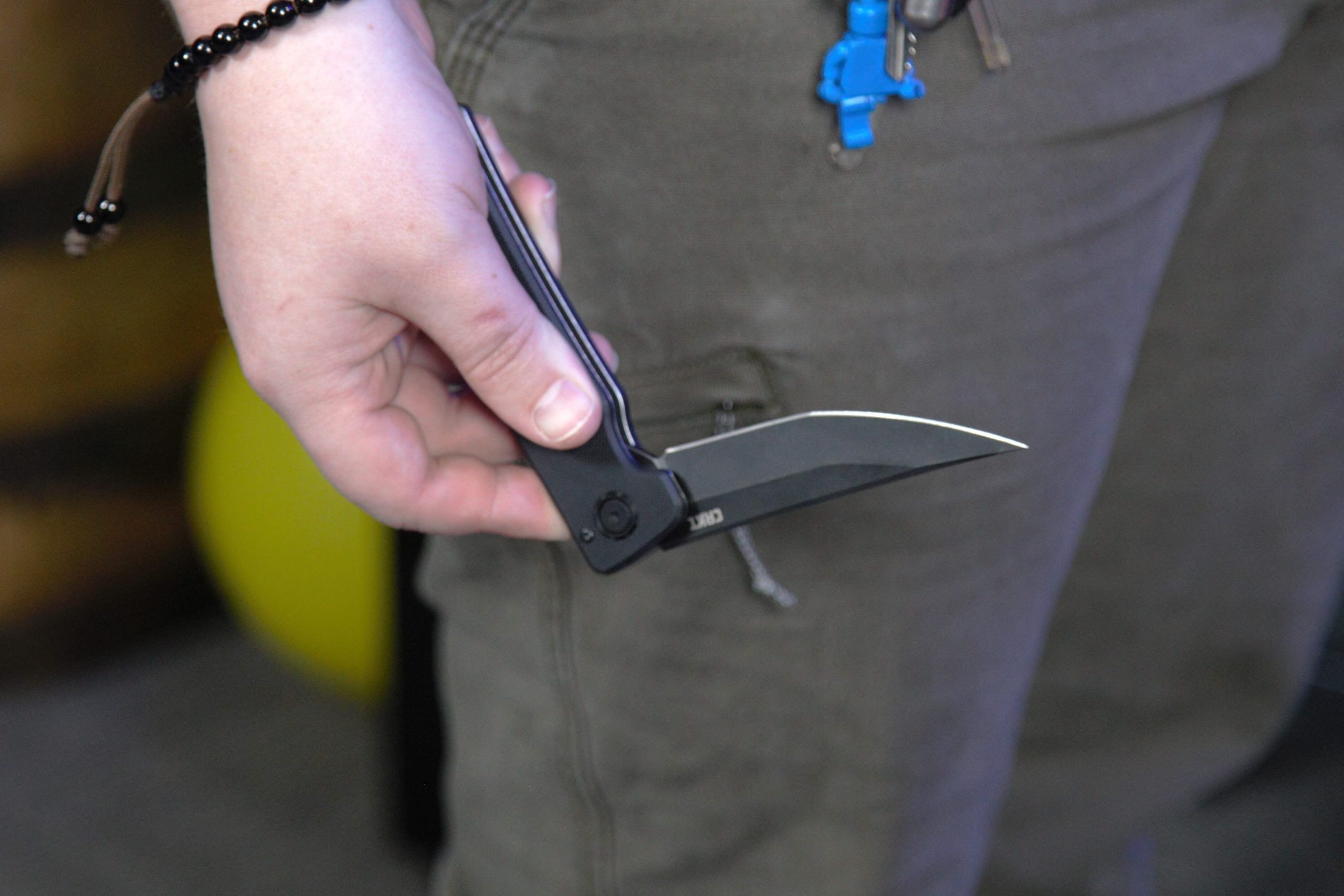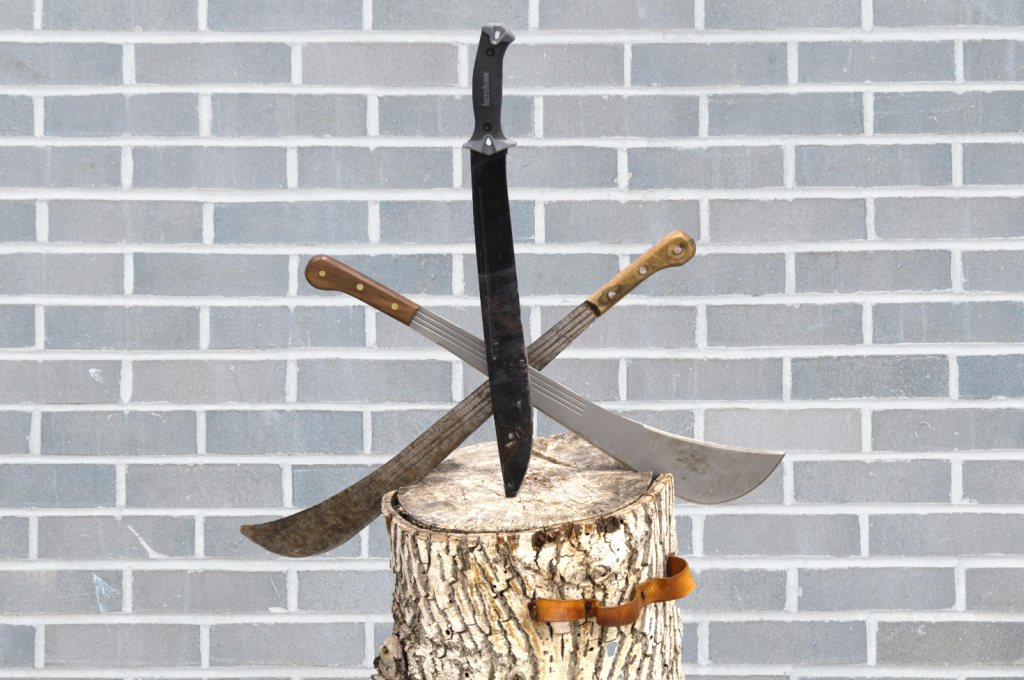
When I was a little boy, I was at some big box retailer and saw a rack of machetes for sale, and I had to have one. It had a long and broad blade that wanted nothing more than to swing from my hand, mowing down grass, saplings, or zombies, as the case may be. Best of all, I saw its price tag – $4.99. Somehow, I convinced my brother to take me back when my mother wasn’t there to tell me no so I could buy it, and that blade was mine. Fast forward a couple of decades, and I am a blog writer for Blade HQ, swimming through an ocean of childish nostalgia about machetes. I have many fond memories of taking that cheap-o machete on hikes through the endless canyons of Wasatch mountains, clearing overgrowth, chopping firewood, and showing cattails who’s boss. While its materials and build don’t impress me today, its ability to do so many tasks and only cost $5 earned my respect.
Today, I’m going to tell you everything you need to know about machetes so you can find the best one for you. It will probably cost more than $5, but not too much more…
What is a Machete?
A machete is a tool with a long, thin blade designed for swinging and chopping. Many tools blur that line, with some looking more like axes, others like knives, others like swords, etc. But all definitions aside, it’s easy to identify a machete when you see one.
We use the term “Machete” to encapsulate many similar cutting tools, from the crudest bronze-age tools to the most modern of steel variants. The story of machetes is longer than recorded history, and some version of this iconic tool played a role in the development of most of the world’s societies.
Do you need a machete?
If you live in the United States, probably not, but a machete can make your life a lot easier. Let me explain. Machetes are some of the most versatile tools ever created by humans, and I don’t say that with bias. There’s a reason machetes have become more common than running water in much of the developing world. They’re economical, user-serviceable, and infinitely useful.

Why Some People Need Machetes
When I graduated from high school, my parents took me to Brazil to see the Amazon Rainforest. There, I saw dozens of people using machetes as part of their daily lives. Let me list just a few of the uses I saw with my own eyes.
- Mowing grass
- Dispatching chickens, fish, and small mammals
- Cleaning and butchering animals of every size
- Clearing paths through brush
- Preparing food like a chef’s knife
- Flipping food on a griddle
- As a paddle for a small canoe
- Harvesting crops
- Removing insect nests from trees
- Bushcraft tasks like traps and triggers
- Scraping shavings from wood and sparks from rocks for fire
- Swatting flies
- Trimming fingernails
- Construction carpentry
- Cutting vines for purposes of swinging (this one was fun)
- And so much more!

This is just a sampling of what I, an American, saw in one part of the world on a two-week visit. That doesn’t include anything like defending one’s home, scraping chyme out of beef tripe, or any of the less attractive parts of life in the developing world that curious Americans don’t get to see. If anybody ever asks you, “Why would anyone need a machete,” remind them that millions of people worldwide depend on machetes for their livelihood. Maybe YOU, the resident of a stable country with plentiful grocery stores, a well-defined division of labor, and potable water on tap, can live a long, happy life without one, but to say that NOBODY needs a machete is nonsense.
Why You Might Want a Machete
But do YOU, the resident of the aforementioned developed country, have a yard? Enjoy hiking? Need some exercise? If so, then a machete might still be a good idea. Machetes can do the work of a lawn mower, a weed whacker, a hedge trimmer, pruning shears, and more. It’s not as easy as power tools, but it’s way cheaper, and most Americans don’t get the exercise they need anyway. If you’ve got a bush hanging over your sidewalk, a machete will get that bush back in compliance in a few satisfying swings. If you’re blazing a trail, a machete can make sure hikers don’t hit their heads on branches and leaves. Yes, there are power and even hand tools that do all these jobs better, but a machete can get them done, and it’s just one handy tool. If you don’t have the perfect tool for a job, give the machete a whack at it! Lastly, while I’m no psychologist, I have always found hacking something inanimate in half to be vaguely therapeutic…
So, do you need a machete? If you’re reading this, probably not. But even if you are reading this, a machete can be a helpful quality-of-life upgrade to your tool collection!
What makes a good machete?
A good machete will be light and balanced, designed properly, and properly sized to meet your needs. A bad machete will miss out on these traits, often to meet a price point or to resemble something from an Anime. If you want your machete to become a trusted companion for years to come, here are some traits to look for.
Blade Thickness
Machetes, like everything, are bound by the laws of physics. The thicker your machete, the more force it will apply, but the thinner your machete, the deeper it wants to cut. “But I want both,” I hear you say. Well, a good machete has you covered. Good machetes often have a much wider blade near the tip than the handle, which gives the blade more mass near the tip for cutting hard and keeps the blade thin for cutting deep.
A thin machete is lighter than a thick one, so it’s easier to carry, easier to swing, and faster to swing as well. The speed of your swing determines how well it will cut, not the strength of your arm. Don’t believe me? Go try to cut down some tall grass with an axe and tell me how it goes. You need more speed, and thin, light machetes will give it to you.
A thin blade also allows the machete to flex a little. This helps absorb shock while cutting, tires your hand out a lot less, and enables you to use that bendy blade for some applications like smoothing wood. More importantly, that flex, afforded you by the thinness of the blade, means that your machete will flex and return rather than just breaking under high pressure.
As a side note, if your machete is thin and long enough, you can play it kind of like a saw if that’s your thing.
Design
A good machete will have a simple, usable design that won’t give you much trouble in sharpening. As with all cutting tools, the most versatile blades are the simplest. Specialized tasks may call for unique and striking blade styles, like the combat chopper Kukuri, carpentry-oriented Nata, or crop-specific Cane machete.
While these are far from the only machete styles that would serve you well, I have a few recommendations for places to start.
Latin

First is the standard Latin-style blade. This one has a ruler-straight spine, a gentle widening taper toward the tip until it rounds off with a section of belly. It’s a great design and has been popular as long as machetes have existed. As its name suggests, this one is most popular in Latin America, but its design is so simple that equivalents of it are made worldwide.
Panga
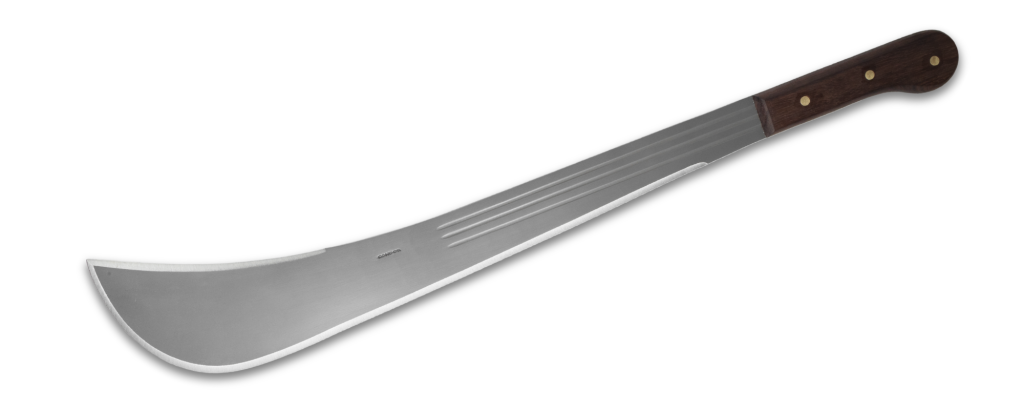
This one is my favorite. It’s like the Latin blade from before, but its spine sweeps back near the tip giving you a bit more belly for slicing and a more hatchet-like weight distribution for chopping, with some even sharpening the spine along this section. My favorite thing is the point, which on this one, is accessible from the spine, sort of like a billhook. Turn the blade around and use it like an ice pick, move firewood around like a hookaroon, and do a ton of other tasks that a simple straight spine won’t allow. The Panga was first made in sub-Saharan Africa. In fact, the Panga is proudly emblazoned on the flag of Angola! In the 1800s, it made its way to the plantations of the Caribbean, and it is still a staple of daily life for many people there.
Bolo
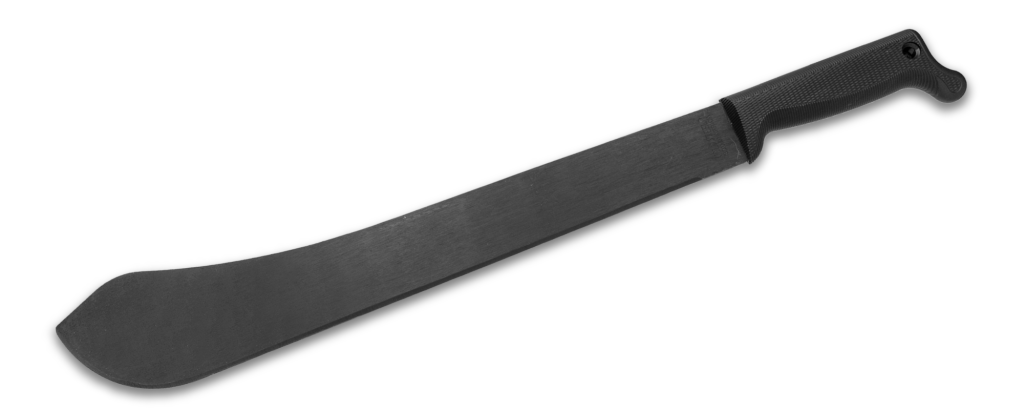
The Bolo is characterized by a bulbous curve near the tip that gives it some extra weight, but a clip to the point that keeps the tip indexed with the handle. I think of the Bolo kind of like a cross between the Latin and Panga styles, giving you some of the benefits of both. The Bolo first came to prominence in the Philippines during the Spanish occupation, where it often made its way from the farm, where it harvested rice and mung beans, to the battlefield, where its users fought for Filipino independence.
Other patterns to check out are the Parang, the Barong, and the Golok. But whatever machete you end up with, make sure you use it right and treat it well, and it will love you back.
Before we move on to the next section, I have a quick note about sword-inspired machetes. These are cool, plain and simple. They can often do the work of a machete, but they are designed after weapons. They are often much more economical than more faithful reproductions of their source material and make great backyard ninja tools, home defense weapons, and costume additions. But for all their fun, sword-style machetes are often left behind when it comes to more utilitarian work like trailblazing and agriculture.
Size
With machetes, bigger isn’t always better. Big machetes can cut harder, but they’re heavier and take more energy for you to swing. In places where food security is an issue, this translates to more calories burned, which isn’t necessarily a good thing. Big machetes also require more space to use, more time to swing, and have a lot more force behind them if they miss their mark. Lastly, if your machete is too long, missing your target can put its tip in the dirt, destroying your edge. Big machetes are still useful, but they’re not going to give you as much versatility as something smaller.
But the pendulum swings the other way too. A machete that is too small will lack conviction in its swings and behave more like a general use fixed blade knife than a machete. That’s still a good thing, and I have many fixed blade knives and love them, but you didn’t get a machete to carve feathersticks and whittle figurines. You got one to chop!
For me, the best blade length for a machete is between 12 and 18 inches. This gives me enough length to get some real momentum on the tip but not so long that it takes more than a flick of my wrist to get the machete moving. Much shorter, and I would just grab one of my fixed blade knives. Much longer, and I would get tired too fast. Your mileage may vary, and your circumstances may call for something longer or shorter, and that’s OK.
Machete Accessories
A machete on its own is one of the most capable tools ever created, but a few bits and bobs can help level it up.
Sheath

Perhaps the most important thing you can add to your machete is some way to cover the edge. When not in use, the edge of a machete can cause accidents. This is most often a sheath that comes with the machete, but you can make one from leather, canvas, or even just make a simple edge guard by slicing a groove into a piece of old garden hose and putting that over the edge. My brother-in-law has an old machete he got from a sugar cane farmer in Guyana, and he keeps it protected in the same cloth sack in which he received it. Machetes aren’t as sharp as knives, so they don’t need the same level of protection.
Sharpener
A sharpener might also be a good idea. Machetes are cutting tools after all, but seldom do their users keep them as sharp as they’d keep a knife. It takes a lot of time and energy to keep a long edge that sharp. Knowing how to sharpen a machete is a different beast, but we’ll talk about that later. A course whetstone like the Lansky Puck is a great choice for a machete sharpener. If you want to learn more about machete sharpening, we have an entire article telling you how to sharpen a machete!
Lanyard
The last item to consider is a lanyard. This is a simple loop of cordage like Paracord that goes through the lanyard hole in the handle and around your wrist. Some people love them, others don’t. It’s all a matter of preference. A lanyard will keep the machete in your direct possession if you let go, keeping it with you instead of sending it flying and potentially injuring people. But that isn’t always a good thing! Sometimes, it can swing from the lanyard and hit your legs or even swing up a little higher and give you some injuries of a more, well, private nature. As a rule of thumb – no lanyard is probably safer for you, but a lanyard is probably safer for people around you. Choose carefully!
How To Use a Machete
Machetes are meant to be swung and to chop things. Sure, they can squeeze into jobs like slicing, carving, and other work usually done by a knife, but machetes like to chop. To get the best chop out of your machete, don’t grip the handle like your life depends on it and hack at the tree like you’re William Wallace in the Battle of Stirling. Grab the machete loosely around the handle and allow the blade lots of space to rotate. This will help the blade swing faster and prevent blisters on your thumb. When swinging, do so gently but quickly, and give your wrist an authoritative flick. This will make the machete swing very fast, but it won’t wear you out as quickly.

I’m going to let you in on a little secret about edges, whether they be on knives, machetes, axes, or otherwise: edges like angles. Even though it isn’t the shortest path through the material, for some reason, edges bite deeper along angles. Keep this in mind when swinging your machete. Chop with a wide, downward arc that intersects with your branch at an angle, and you’ll be surprised at how deeply it bites, even in thick branches.
Other cutting jobs may require you to swing sideways, like cutting grass low to the ground. All the same rules apply; just focus on keeping your swings fast. That speed will maximize the tearing force the machete has.
But don’t feel like any other way you’re using your machete is wrong. Uses of a machete are limited only by your imagination!
What companies make good machetes?
Condor Tool & Knife
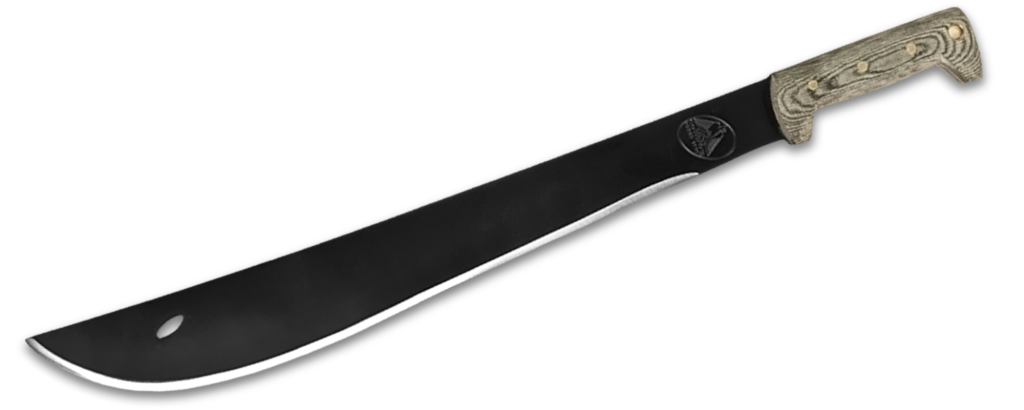
My favorite machetes come from Condor Tool & Knife. They’re made in El Salvador by people who grew up using them and are now committed to making the best machetes possible. They are a bit spendy, but in my opinion, they’re worth it. I got my brother-in-law a Condor Viking Machete, which is a Panga-style machete, and it outchopped my small axe on a campout. Very impressive!
Tramontina
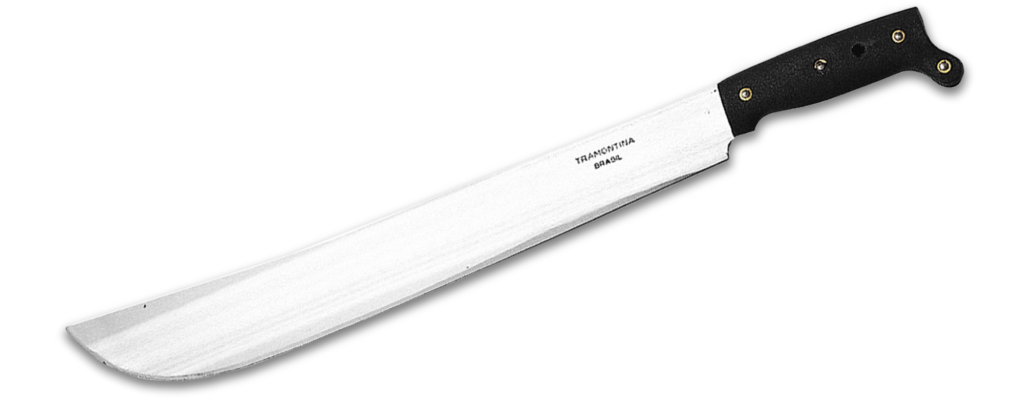
If you’re looking to save a bit of money, I love the Tramontina machetes. These are made in Brazil and belie their price with their quality. The most expensive Tramontina at Blade HQ costs about $17, but they’re all made from well-treated carbon steels and have either hardwood handles or durable plastics. They don’t come with sheaths, but as mentioned earlier, that’s an easy problem to fix.
Cold Steel
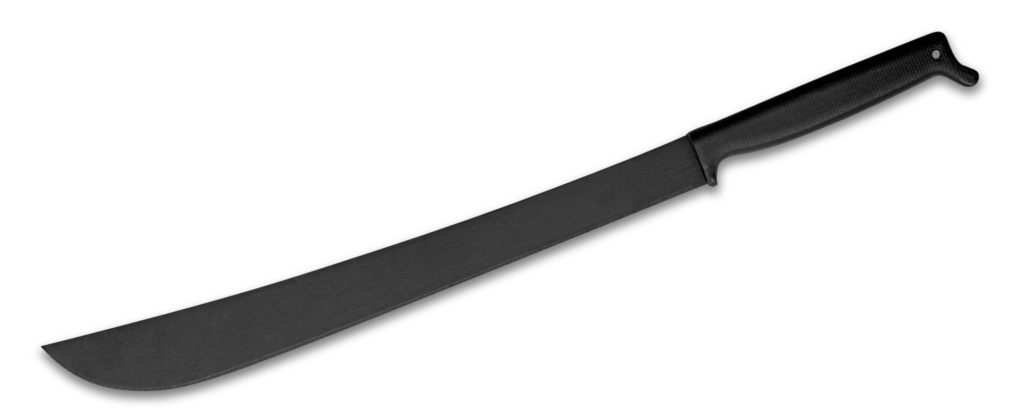
Cold Steel makes a slew of machetes and many in the style of swords. I love that their machetes are made in South Africa, one of the most underrated cutlery powerhouses in the world. They’re very well-made, quite affordable, and have top-quality sheaths sold separately. Also, if you’re after a two-handed machete, Cold Steel is about the only name in the game!
Gerber

The Gerber Gator line has been popular for years now, and they’re great tools. Some of them have saw backs, making them a little more useful if you’re doing harder woodwork where chopping won’t solve all your problems. When I was in Brazil, one of our forest guides carried the Gerber Gator Jr. with him every day. Being the daily driver of a professional rainforest guide is high praise indeed!
CRKT

CRKT makes the ChanceInHell, which has a very broad blade and is sharpened almost all the way to the hilt. This one feels the most like a traditional fixed blade of the machetes I’ve talked about here. If you’re coming to machetes from a background of fixed blade knives, I’d give this one a look. Also, of all the machetes we talked about in this article, this one has one of the best sheaths.
Kershaw
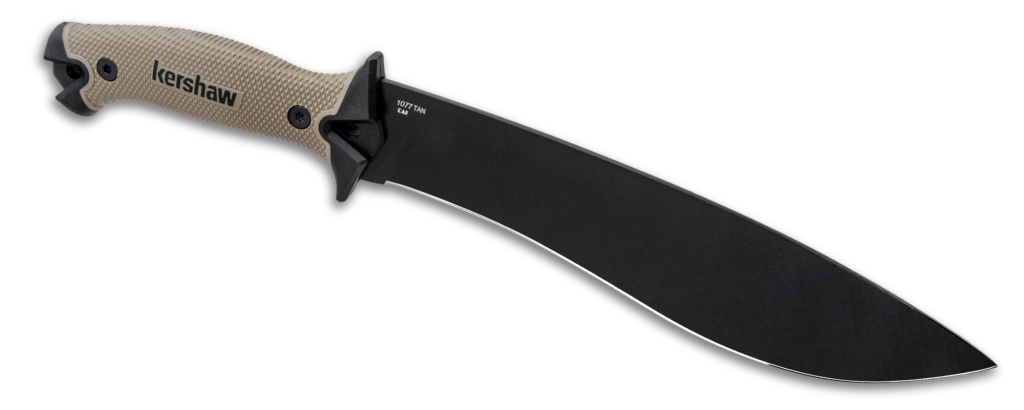
My personal machete is the Kershaw Camp 18, and I love it. Its handle is super comfy, and it’s one of few machetes with a full polymer sheath. Sadly, this epic blade is discontinued, but don’t fret! The Camp Series, and most notably its little brother, the Camp 10, is alive and well. This one looks a little like a Kukri, but its edge is mostly straight. It shouldn’t give you much trouble when sharpening, and it will be a great chopper. It is a bit small, and to my hand, it’s more a knife than a machete. But it’s a great tool nonetheless.
ESEE
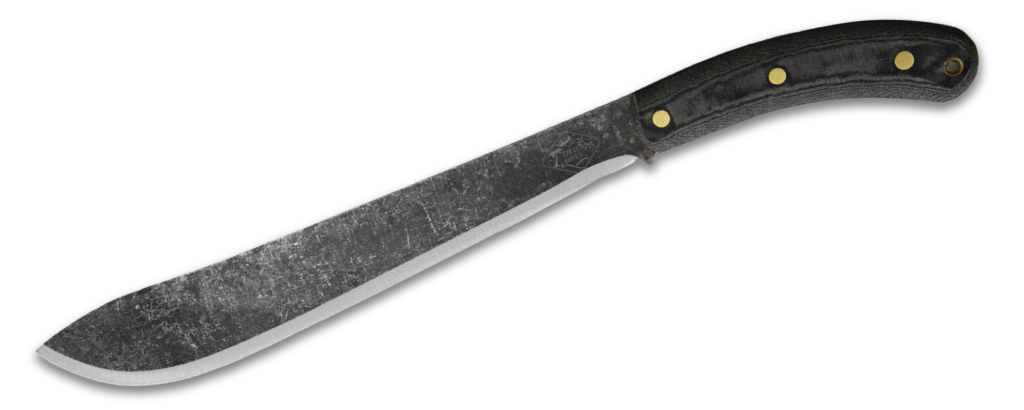
ESEE is known for its fixed blades, but their machetes are 10/10, too. My favorite ESEE Machete is the Darien. It comes with a sheath, has a nice Scandi grind, and is one of the few machetes out there with a micarta handle. It’s on the smaller side but can still do some real work. Best of all, it’s backed by ESEE’s unrivaled warranty. In short, if you break it, no matter how, they’ll replace it, no questions asked. You’d think that means they’re using a cheaper steel than the competition, but no! They’re using 1075, a higher carbon steel than most of the machetes we’ve talked about! Great blade steel, great handle material, great build quality, great warranty, great sheath, all under $100? Sign me up!
MY Parang
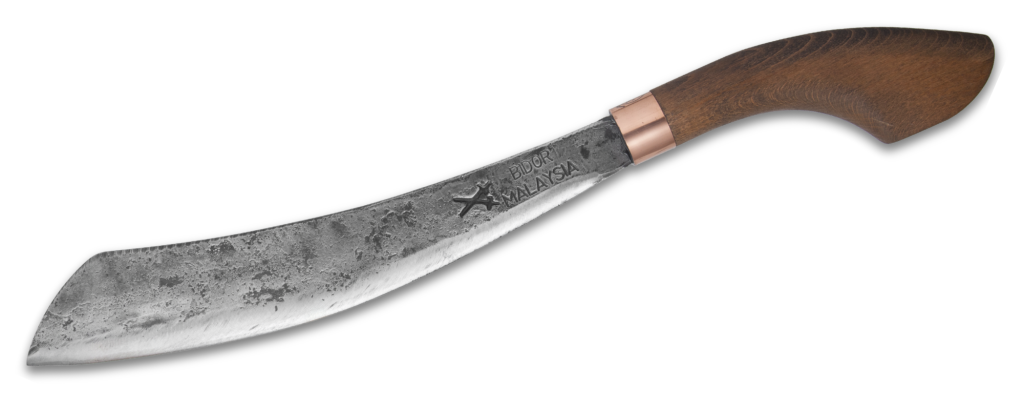
The last brand I want to put on your radar is MY Parang out of Malaysia. They specialize in the machete styles common to Malaysian people, specifically the Parang and the Golok. Each one is hand-forged and expertly heat-treated from 5160 spring steel (which is on another level entirely from all the steels talked about so far), given a proper convex grind, and outfitted with a beautiful beechwood handle with a copper bolster. Each also ships with a nylon sheath. They’re very nice, but they only make machetes with about 10”-12″ blades. If that sounds perfect for you, I’d seriously consider MY Parang!
A Word About History
I’ve kind of danced around this subject in this article, but it’s no secret that the history of the machete has a lot of blood in it. I will not pretend this isn’t the case, but rather, I concede this is an inevitability. Whether or not their causes are just, when people in less-developed countries are galvanized into combat, what weapon should they reach for? Tools of warfare used by the United States all require a robust supply chain, which, even during peaceful times, these people don’t have. What other choice do they have than the versatile machete they’ve used in their farms, trails, and communities for centuries? And when journalists show up to photograph the affair, all they see is people fighting with machetes, as though machetes were first and foremost weapons. If you google “machete news,” all you’ll see is violence and crime. This annoys me.

The Truth
Sure, machetes can be formidable weapons, but to claim that they are purpose-built killing tools is ridiculous. A half-second of critical thinking reveals that machetes are used in these applications because they are the best weapon available to their users. If combatants had access to firearms and plentiful ammunition, their machetes would be gathering dust at home. The only reason you see machetes portrayed as evil and dangerous in media is because violent crime sells more papers than harvesting sugar cane.
History books look at the machete from the surface level only. Historians couldn’t care less about how many crops were harvested by machetes. But they write volumes about awful things done by violent machete users. But for every crime against humanity committed with a machete, there were millions of wholesome, utilitarian tasks done with one somewhere else. People need to stop thinking that machetes are inherently evil, and the history books need to get their facts straight!
Should You Get a Machete?
In my opinion, yes. Machetes are usually very affordable, they’re easy to store and maintain, and they offer versatile utility unrivaled by just about any in your garage. Mine sees frequent use in tree pruning, clearing out the garden at the end of the season, and on trips to the family cabin to make sure the road is clear of overgrowth. Do I use it every day and depend on it for my livelihood? No. But is it a burden for me to keep in my garage while not using it? Absolutely not. And am I grateful to have it when I need it? You bet your Bolo!
So go grab yourself a machete and get to work!
